Originally hand-printed and bound for friends in an edition of just 30, Rena Gardiner’s ‘Portrait of Dorset’ has recently been reissued by Design For Today. It is rightly considered to be her masterpiece, writes Jon Woolcott.
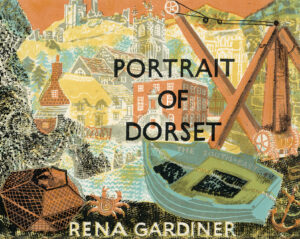
Tarrant Monkton is a Dorset village of stone and thatch in a shallow river valley, forded by a packhorse bridge. In 1965 the artist Rena Gardiner moved here, to a cottage where she was to spend the rest of her life, making her art, setting up a workshop and creating books, binding and printing them herself. Aligned with mid-century artists like Ravilious and Bawden, in common with many of her contemporaries she favoured lithography, or ‘auto-lithography’, in which the artist makes their mark directly onto the printing surface. In Gardiner’s case the results were imbued with tremendous immediacy, energy and occasional subtle but sly humour.
That she chose to make her living so remotely, and as her biographers Julian Francis and Martin Andrews have pointed out, that she was so uninterested in publicity, meant that her sudden death in 1999 at the age of seventy, was practically unmarked. To this one might add that she was a woman, in an age of the (male) artist as star.
Gardiner’s work ranged widely, but Dorset was her muse. Five years before her move to Tarrant Monkton, Gardiner created the book Portrait of Dorset: The South East, and published it herself, taking three years to make the lithographs, write and set the text, producing just thirty copies. The publisher Design For Today has just reissued Portrait of Dorset in a facsimile edition, with an added, useful ‘appreciation’ of Gardiner which includes a brief biography and a summary of her working methods, written by Joe Pearson, the publisher.
The book is rightly considered to be Gardiner’s masterpiece. In later life she created several large format books about Dorset (including The Isle of Purbeck, also sometimes available as a facsimile edition from Dovecote Press), but while Portrait of Dorset covers only the south-east of the county, the variety of her landscapes: the countryside, towns, villages and the coast give us more than enough to pore over.
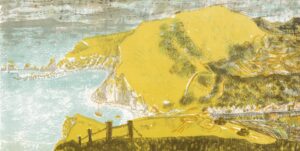
Bindon Hill by Rena Gardiner, taken from the new edition of Portrait of Dorset: The South-East by Rena Gardiner (£75, Design For Today)
I was so pleased to have the opportunity to spend time with this book – Gardiner’s vigour, her sense of detail, space and place shine through on every page. Her gaze was unflinching – she had little interest in the picturesque. She lived in a picture-postcard village, but close by are the remains of a Second World War airfield, and it was in this tension between the traditionally pretty rural scene and the messy stuff of life where she often worked. She appreciated beauty but saw it in many places. She sketched little tanks as part of the military landscape on Bindon Hill, around Tyneham, requisitioned for the army in the Second World War, and never returned to its inhabitants. Her subjects included Poole Power Station, murky and massive under a grey sky. Sometimes she restricted her colour palette, flooding the page with a single colour, but somehow the effect is to accentuate the subject, rather than subjugating it to her style. Indeed, as I read the book, I came to see that her approach differed from many of her counterparts in this regard. Gardiner is probably most closely associated with John Piper; they shared many of the same passions and concerns, notably of architecture and its atmospheres. I love Piper fiercely, but when I look at his work, I feel that he’s ever present, tapping me on the shoulder, telling me he is the artist. Gardiner instead looks levelly at her subject, and while her creativity flowed freely, she’s unafraid to let the place tell her things she wasn’t expecting.
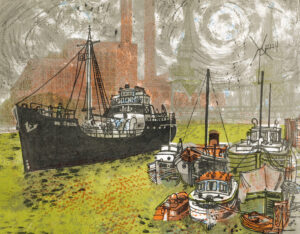
Poole Harbour and Power Station by Rena Gardiner, taken from the new edition of Portrait of Dorset: The South-East by Rena Gardiner (£75, Design For Today)
An example is Corfe Castle, standing high on its mound, guarding the Isle of Purbeck, although since the Civil War, somewhat uselessly, as it was slighted by the Parliamentary forces and left as a dramatic ruin. Gardiner returned to Corfe over and over. But her rendering of the castle often places it in the background – sometimes including only part of the structure. She fills the frame instead with everyday modernity: a van parked in a makeshift garage, a couple on a bench outside the pub below the castle. Unlike many of the mid-century English lithographic artists, Gardiner was a people person. Humans and their workings are everywhere in her art, and even when they’re not we sense that they’re just out of view, having left their tools or lobster pots in the picture, just a moment ago.
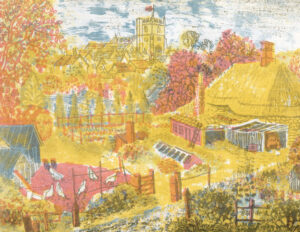
Vineyard Farm and the village, Corfe Castle by Rena Gardiner, taken from the new edition of Portrait of Dorset: The South-East by Rena Gardiner (£75, Design For Today)
The lithographs in Portrait of Dorset have primacy over the words. Rena Gardiner wrote the text herself, as she did throughout her career, for commissions which included work for the National Trust, but she had no real interest in typography – the words serve the purpose of accompanying the art and have no intrinsic beauty in themselves, but still, she used them to convey her opinions. Bere Regis, she tells us, is a ‘dull place’. She is never taken in by the view alone. Too many cottages, she writes, ‘remain rural slums.’ It’s clear too that her sympathies lie with the labourers of Tolpuddle, transported to Australia for their membership of a Trades Union and agitating for better wages when they were ‘virtually slaves of the soil and the landowner.’
Portrait of Dorset is a fine and beautiful book, carefully and lovingly re-published. Inevitably, as Rena Gardiner produced the original run by hand, no two copies were identical, and this new edition has necessarily removed inconsistencies and ironed out her occasional idiosyncrasies (although one very minor and entirely understandable typo remains on the contents page). Gardiner was always concerned to keep her work affordable, even if this meant a life of occasional hardship, but since her star has begun to rise again, post-mortem, so have the prices of her limited run books. In recent times original copies of Portrait of Dorset have occasionally come up at auction and sold for more than £2,500. We should be grateful then for this volume, which should do much to introduce this extraordinary artist to a new and appreciative audience.
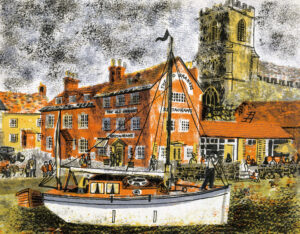
Wareham Quay by Rena Gardiner, taken from the new edition of Portrait of Dorset: The South-East by Rena Gardiner (£75, Design For Today)
*
‘Portrait of Dorset: The South East’ is published by Design For Today in a limited edition run of 600 £75 copies, with a further 150 special edition copies, in a slipcase by Ludlow Bookbinders, at £150. Both editions are available here.
Jon Woolcott works for the independent, Dorset-based publisher Little Toller Books. His book, Real Dorset, is out now, published by Seren Books. Follow Jon on Instagram here.